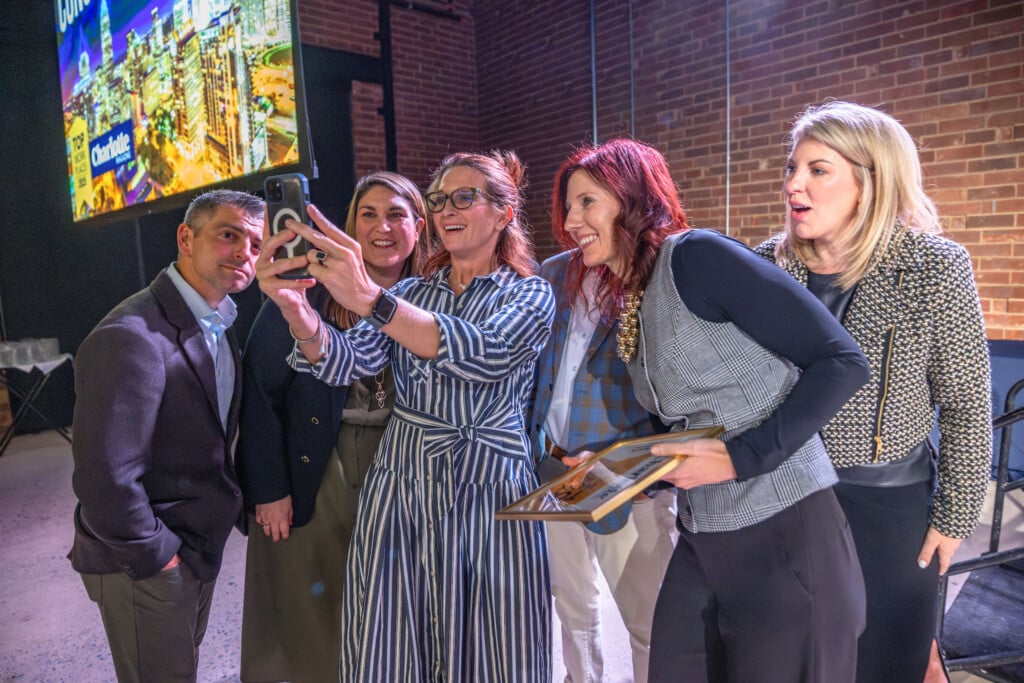Could Charlotte Become the Most Connected Community in America?
The Center for Digital Equity is connecting Charlotte bit by bit

In 2020, the National Digital Inclusion Alliance moved its annual conference online. Seemingly everything became bits and pixels that year: school, work, doctor’s appointments, exercise classes, game nights. On Zoom, digital equity leaders convened to discuss how to expand access to the online world, which had effectively become the whole world.
Before the pandemic, digital equity was a wonky, specialized issue that many civic leaders didn’t firmly grasp. Advocates often had to explain what they did and why it mattered. But by the end of 2020, everyone knew.
In Charlotte, the Center for Digital Equity, housed at Queens University but comprising a range of private and public partners, is a hub dedicated to expanding access to the internet, devices, and digital skills through training, advocacy, and coordination with stakeholders. In July, the CDE released its first annual impact report, which assesses its progress and makes plain how much work remains.
To effectively bridge the digital divide, everyone—including the most disadvantaged—must have not only devices and a broadband internet connection but also the skills to use them. This access, says Bruce Clark, the CDE’s executive director, “is the rebar in the foundation of life in the modern world.”
The digital divide transcends the urban-rural fault line that splits the country on so many other issues. Rural regions often lack the infrastructure for high-speed internet service. In urban areas like Charlotte, the biggest obstacle is not infrastructure—most of the city is wired—but being able to afford it.
Wealth and education gaps feed a destructive cycle of intergenerational inequality. Affluent households can afford better educations for their children; those that can’t afford those opportunities are left behind—and the cycle continues. Digital and racial equity are intertwined. As a 2022 study in The Review of Black Political Economy spells out, “The intergenerational transmission of racial wealth inequality likely played out at rapid speed during the pandemic.”
A map of Charlotte’s broadband connectivity rates reveals the familiar wedge-and-crescent pattern of the city’s income inequality. The most connected areas, including the wealthy wedge, have 91% connection rates. In the city’s six Corridors of Opportunity, historically underserved areas that include West Boulevard, Wilkinson Boulevard, and Beatties Ford Road, those rates can drop below 80%.
During the pandemic, the federal government allocated $14 billion to the Affordable Connectivity Program to subsidize digital devices and broadband internet service for low-income households. So far, the program has provided aid to more than 20 million families. Just two years after it launched, the program is running out of money, a sign of how widespread and intractable this problem is.

CDE partner E2D collaborated with Barings, an investment management company, to distribute laptops at the Evoke Living at Westerly Hills apartments.
The origins of the Center for Digital Equity go back to 2015, when a group of stakeholders—the Charlotte Digital Inclusion Alliance—began meeting regularly to advance digital equity. Digital Charlotte, which encompassed ongoing digital equity work at Queens, and the Charlotte Digital Inclusion Alliance combined in October 2021 to form the Center for Digital Equity, a backbone organization to corral community partnerships toward its goals. In 2021, as part of the Mayor’s Racial Equity Initiative, the city allocated the CDE $20 million in private-sector funding to lead efforts to close the digital divide.
Clark has led the CDE for eight of his 18 years in Charlotte, but his awareness of the issue stretches back to high school in the early ’90s in Libertyville, Illinois, a Chicago suburb.
“I was probably supposed to be going to the bathroom between classes, and I decided to veer off into some storage room,” he says. He found a stash of Apple IIe’s. That day, his Model United Nations group discussed the challenge of bringing technology to the world. “And I remember thinking, My gosh. At the time, these Apple IIe’s weren’t that old. What are they doing locked in this closet? Nobody’s able to use these in this closet.”
In retrospect, Clark sees this moment as the seed of his future work, but he didn’t recognize it right away. In Charlotte, he was a deputy regional field director during Obama’s 2008 campaign, campaign manager for Anthony Foxx’s successful 2009 mayoral campaign, and he led The PPL, an independent media hub during the 2012 Democratic National Convention.
In 2015, Clark became the city’s first digital inclusion project manager, responsible for developing an inclusive connectivity plan. That position, like the CDE, was funded through a grant from the Knight Foundation and based out of Queens University.
Clark and the CDE conduct a chorus of stakeholders: residents, businesses, nonprofits, and government entities. Soon after the organization joined the Mayor’s Racial Equity Initiative, they were already in touch with more than 115 partner organizations and constituents.
“You’ve got a lot of different people who have an opinion,” Clark says. “How do you present a ‘community’ strategy and have it not only reflect the community but then have, for lack of a better term, the buy-in from the organizations who are required to effect change?”
He thinks his experience in politics keeps the CDE from getting mired in conflicting goals and group-project inertia. “I’ve been at the center of power in this community,” he says. “I’ve seen the good, the bad, and the ugly, so there’s a level of strategic perspective that I think has helped guide some of the way we’ve structured this to be mindful of those potential concerns.”
The CDE’s impact report, peppered with big numbers, would seem to support his claim. Between July 2022 and June 2023, CDE partners Charlotte Mecklenburg Library and E2D distributed more than 27,000 laptops. The CDE informed 13,000 residents about affordable broadband access programs. The CDE’s team of Digital Navigators helps families address connectivity issues, sign up for internet service, purchase devices, and learn digital skills. Last year, they responded to 614 requests. This year, ticket volume increased to 3,050.
Behind these numbers are individuals whose lives have transformed thanks to digital access. Clark recalls leading an evening digital-skills course at a school for the parents and guardians of students there. At the end of the training, participants would receive a laptop. Clark invited the school custodians who unlocked the doors for them to join the course. The next time Clark led a training there, one of the custodians who’d taken him up on the offer was no longer there. She’d used her new skills and computer to land a better job.

The CDE held a panel discussion in August with Age-Friendly Mecklenburg, a city initiative to improve quality of life for older adults. The center’s Digital Navigators, like Naimah Martin (below), help users with connectivity and digital skills.
Charlotte made digital equity a priority eight years ago, well before many municipalities recognized it as a civic issue, and the CDE’s impact report showcases major strides. But a widespread lack of internet, devices, and skills still impedes access to education and jobs—plus the community, entertainment, and fun of online spaces. The report’s numbers reflect the dizzying scope of the problem. Eighty percent of job postings are online, and most teachers assign homework that requires an internet connection.
Like homelessness, maternal mortality, and incarceration rates, the digital divide is a symptom of greater societal ills, and free devices and government subsidies are little more than Band-Aids on wounds that will persist as long as structural inequality does. As technology advances and the wealth gap widens, the CDE’s task begins to look Sisyphean, and Clark wonders whether these foundational issues will pose “an insurmountable resistance.”
But part of what drives him is the novelty and possibility of the problem. “How we choose to address this issue may look different than how we’ve chosen to address other intersectional issues with racial equity,” Clark says. It challenges advocates to look at long-standing American problems—racial and wealth disparities, among others—in a new way and could transform how we approach equity issues in an increasingly tech-driven landscape.
One cause for hope, he says, is that it’s a bipartisan concern. He hopes Congress will come together to commit more resources to the Affordable Connectivity Program and other digital equity efforts. In the meantime, the CDE will fight to expand access to the tools and skills families need to participate in the modern world. Its impact report betrays a technophile’s optimism: “Becoming the most digitally equitable community in America is within reach!”
Charlotte’s Digital Divide
- The digital divide is the gap between those who have affordable access, skills, and support to effectively engage online and those who do not.
- Digital equity is a condition in which all individuals and communities have the information technology capacity needed for full participation in our society, democracy, and economy.
- About 14% of households—56,000 homes—in Mecklenburg County lack internet access.
- About 7%—or 26,000—of the county’s households have only mobile internet or dial-up service.
Sources: The National Digital Inclusion Alliance; The Center for Digital Equity
The Five Elements of Digital Inclusion
Digital inclusion refers to the elements necessary to ensure that everyone has access to information and communication technologies, which must evolve as technology advances.
- Affordable, robust broadband internet service
- Internet-enabled devices that meet the needs of the user
- Access to digital literacy training
- Quality technical support
- Applications and online content designed to enable and encourage self-sufficiency, participation, and collaboration
Source: The National Digital Inclusion Alliance






